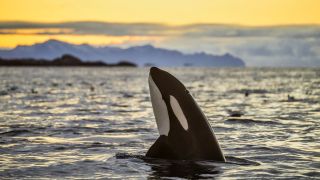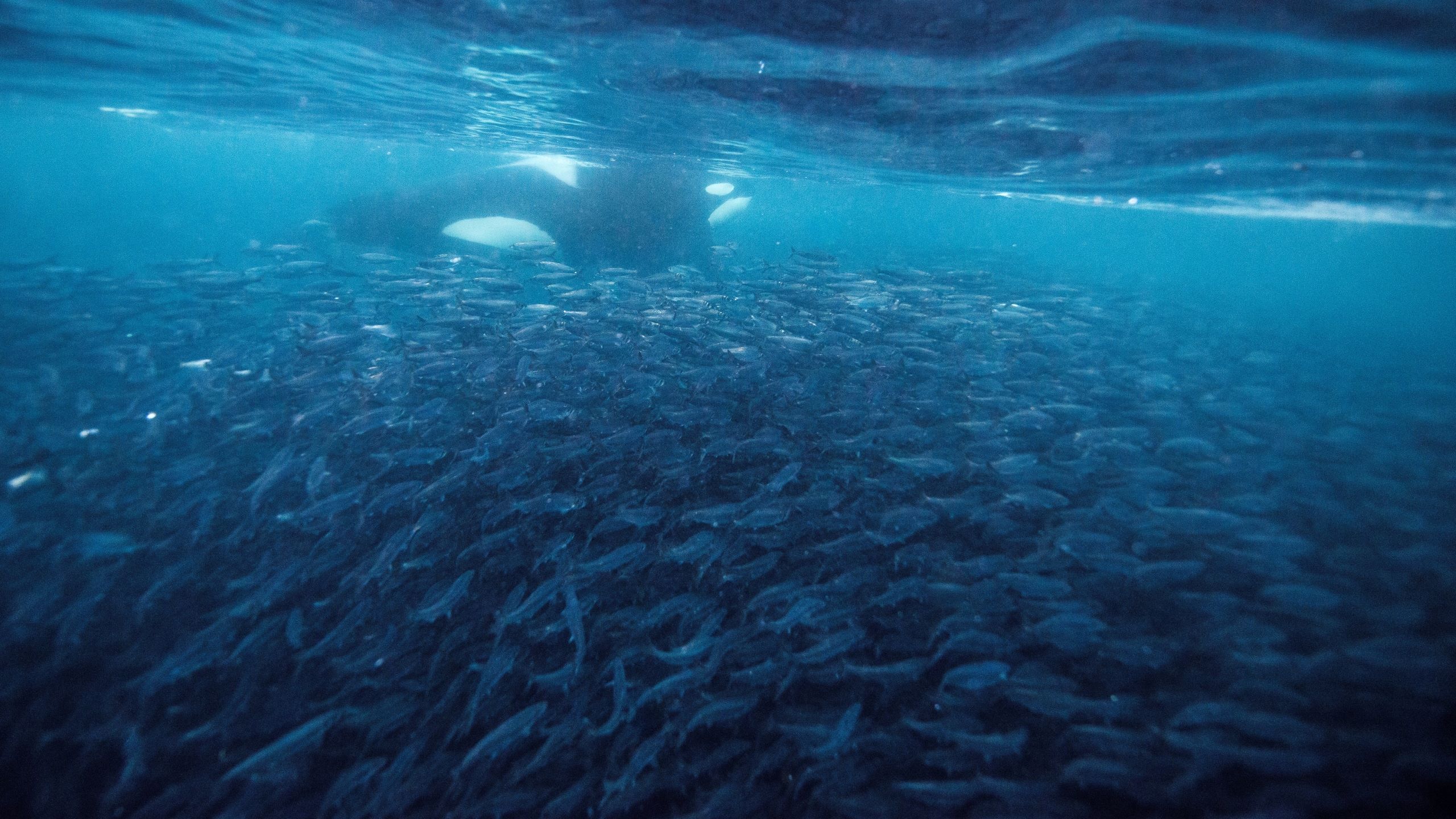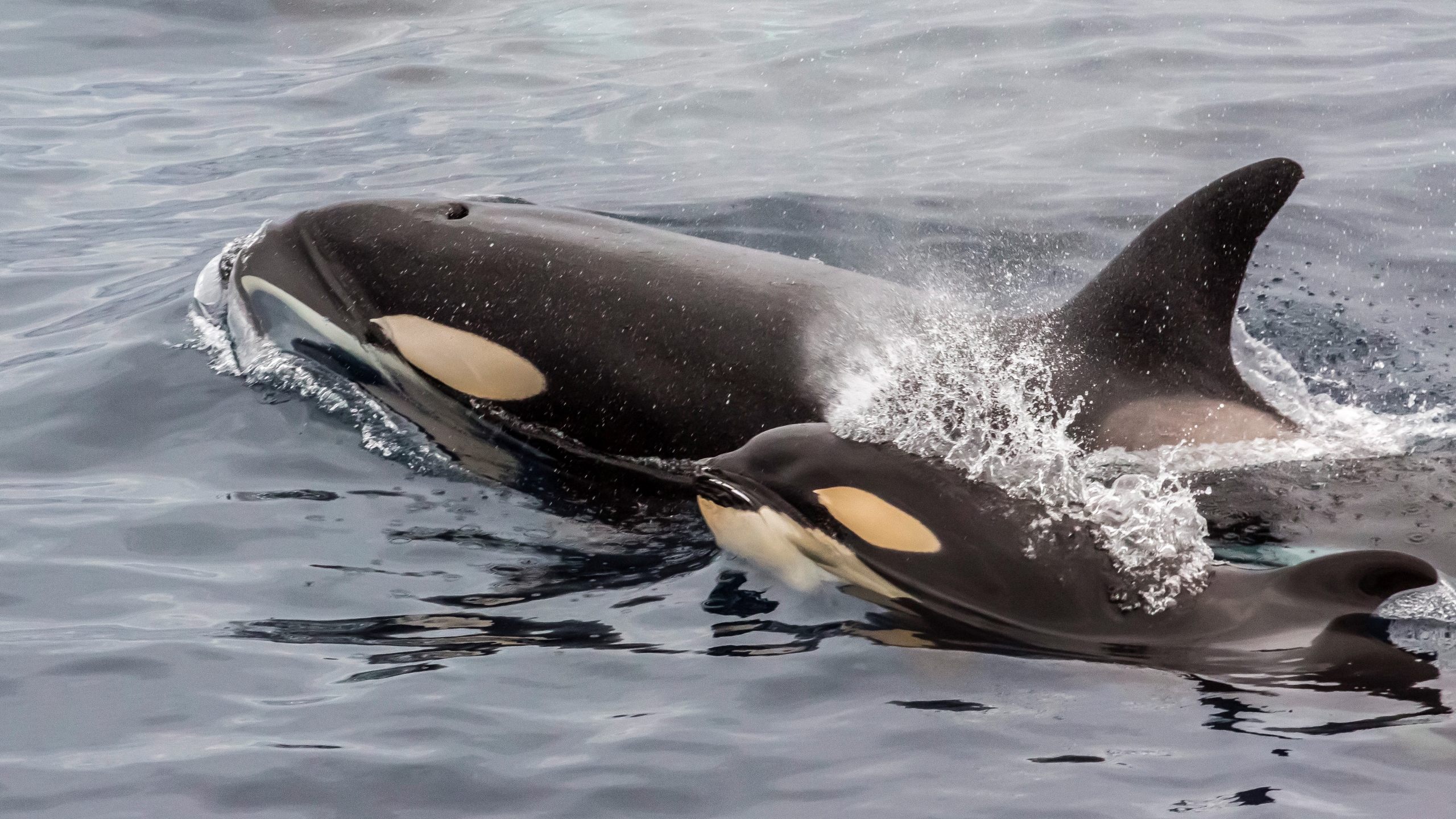How Much Does a Baby Calf of a Killer Whale Weight
Orcas: Facts about killer whales

Orcas (Orcinus orca) are often chosen killer whales, even though they almost never attack humans. In fact, the killer whale proper noun was originally "whale killer," as ancient sailors saw them hunting in groups to take down big whales, according to Whale and Dolphin Conservation (WDC).
Today, orcas are recognized as amongst the most widely distributed mammals on the planet, occupying every ocean. They are incredibly social, various and ferocious marine predators with a diet ranging from penguins to dandy white sharks.
How big is an orca?
Orcas are the largest members of the dolphin family. Males are bigger than females, just they vary in size and weight, depending on the type of orca. The largest orca e'er recorded was a staggering 32 feet (9.viii meters) long and weighed 22,000 lbs. (10,000 kilograms), according to SeaWorld. That'due south longer and heavier than most motorhomes.
Orcas are known for their long dorsal fin (the fin on the animate being'south dorsum) and black-and-white coloring. The black-and-white coloring helps to camouflage them by obscuring their outline in the water. Merely behind the dorsal fin is a patch of grayness called a "saddle" — because it looks like a riding saddle.
An orca's torso is cylindrical and tapers at each end to form a hydrodynamic shape. This shape, along with the orca'southward big size and forcefulness, makes information technology amid the fastest marine mammals, able to reach speeds in backlog of 30 knots (about 34 mph, or 56 km/h). Orcas have massive teeth, which can grow upwards to 4 inches (ten centimeters) long, according to National Geographic.
What exercise orcas consume?

Orcas are apex predators, at the pinnacle of the food chain. No animals hunt orcas (except for humans). Killer whales feed on many different types of prey, including fish, seals, sea birds and squid. They can also take down whales larger than themselves, such as minke whales, and they are the only animal known to predate on great white sharks, according to The Natural History Museum in London. Killer whales have even been reported to kill pond deer and moose, co-ordinate to a chapter on orcas in the book "Primates and Cetaceans ," (Sringer, 2014).
Orcas apply many different techniques to catch prey. Sometimes they beach themselves to catch seals on land, jumping from the h2o onto land. Orcas will too work together to catch larger casualty or groups of prey, such as schools of fish, according to the International Spousal relationship for Conservation of Nature'south (IUCN) Ruby Listing. They tin can employ echolocation to place their prey past creating sounds, or sound waves, that travel through the water. These waves echo off objects, including prey, which the orcas tin use to locate them, according to SeaWorld.
Orca attacks on humans
There is no tape of an orca ever killing a human in the wild. This is considering humans are not office of their natural diet. Occasionally, an orca may mistake a homo for something they do eat, such as a seal. In 2017, an orca was caught on camera charging at a surfer during the Lofoten Masters surfing competition in Norway. The orca seemed to pull out of the attack merely before making contact. The Norwegian Orca Survey said in a Facebook post that the orca probable realized the surfer was not a seal at the very concluding second.
In 2005, a 12-year-old male child was "bumped" by a killer whale near Ketchikan, Alaska, in what may have been an aborted attack — similar to the surfer in Norway — or merely curiosity on behalf of the orca, according to the Associated Printing, via The Seattle Times. The Associated Press reported that a surfer was bitten in California in the early 1970s, which is the only relatively well-documented example of a wild orca actually biting a human being. Orcas in captivity, nevertheless, accept attacked and killed people.
Although wild killer whales do not intentionally harm people, they have attacked boats. In that location were many reports start in the summer of 2020 of orcas ramming into and causing damage to sailing boats off the declension of Spain and Portugal, according to BBC News. Three juvenile male person orcas were involved in well-nigh of the attacks, and marine biologists investigating the incidents believe that the young males were playing with the boats by targeting the rudders and pushing the boats around.
Life in the pod

Orcas are very social creatures and alive in family groups chosen pods, which have up to l members, according to the University of Michigan's Animate being Diversity Web (ADW). These pods are fabricated up of related mothers and their descendants, known as matrilines. A male orca volition stay with its mother for life, while daughters may spend fourth dimension away after having calves of their ain, according to the wild fauna charity Whale and Dolphin Conservation (WDC ). Pods oftentimes have their own distinctive calls, or dialects, to communicate, but they volition acquaintance with other pods and can come up together to form even larger, temporary groups.
KEY FACTS
Size: Up to 32 anxiety (9.viii m) long
Life bridge: Up to 100 years
Conservation condition: Data deficient
A female killer whale will requite nativity to one offspring at a time every three to 10 years. The gestation period usually lasts for around 17 months according to SeaWorld. Orcas work together to take intendance of the young, and other females in the pod will often assist with the rearing.
Female person killer whales have an boilerplate life bridge of 50 years, only some individuals are estimated to have lived upwardly to 100 years. Males live shorter lives, with an average life span of 29 years and a maximum life span of 60 years, co-ordinate to the Heart for Whale Inquiry in Washington state.
Where do orcas live?
Killer whales are the most widely distributed mammals, other than humans and possibly brown rats, according to SeaWorld. They live in every ocean around the world and have adapted to dissimilar climates, from the warm waters nigh the equator to the icy waters of the North and South Pole regions.
Orcas take been known to travel long distances. For example, one study constitute that a group of orcas traveled from the waters off of Alaska to those near key California, according to IUCN — a distance of more i,200 miles (1,900 km).
Are in that location different types of orca?

All orcas are currently listed under one species, Orcinus orca. Even so, there are recognizable differences between populations, and biologists have identified several distinct forms, known every bit ecotypes, which may actually be different species or subspecies, according to the National Oceanic and Atmospheric Administration (NOAA).
Killer whale ecotypes tin can vary in size, diet and beliefs. There are currently 10 described ecotypes: five in the Northern Hemisphere and five in the Southern Hemisphere, according to WDC. In the Due north Pacific, scientists have identified resident orcas, which tend to take pocket-size ranges — hence the name — and specialize in catching fish. Bigg'south killer whales, or transient orcas, tin also be found in the North Pacific. These orcas travel peachy distances and chase mammals such as seals and whale calves. Offshore orcas can likewise exist establish in this region. They live far from coastlines and have been seen eating fish and sharks, but relatively little is known nigh them.
ORCA TAXONOMY
Kingdom: Animalia
Phylum: Chordata
Class: Mammalia
Order: Cetacea
Family: Delphinidae
Genus: Orcinus
Species: orca
The Northern Hemisphere is as well home to North Atlantic Blazon 1 and Blazon 2 killer whales. Blazon 1 orcas are generalist eaters and accept been observed eating fish and seals around European countries, including Norway and Scotland. Type ii orcas are rarer and mainly eat other whales and dolphins.
In the Southern Hemisphere, there are Blazon A, Blazon B (large), Type B (small), Type C and Type D killer whales.
—Type A orcas travel in and out of Antarctic waters, post-obit the migration of their master casualty, minke whales.
—Type B (big) animals are also called pack ice orcas, because they chase seals in Antarctic pack ice.
—Type B (modest) killer whales, besides chosen Gerlache orcas, have been seen eating penguins, but their complete diet is unknown.
—The same is true for Type C and Blazon D orcas, though both of these have been observed eating fish.
—Blazon C, or Ross Sea orcas, are the smallest ecotype and are normally found in eastern Antarctica.
—Blazon D, or subantarctic orcas, are very rare, and there is still much to learn well-nigh them.
Are orcas endangered?
The orca is currently listed equally "Data Scarce" by the IUCN, which ways its conservation condition is unknown. Scientists didn't have sufficient data when it was last assessed in 2017 due to the uncertainty regarding its taxonomic nomenclature — whether orcas should be split into unlike subspecies or species. The IUCN noted that as a single species, the killer whale is abundant and widely distributed. Nonetheless, they still face up threats from human being activities and some regional populations, such as the orcas dependent on bluefin tuna in the Strait of Gibraltar, accept declined significantly.
Human civilizations around the world kill orcas directly and indirectly. They are still hunted for food in small numbers, or equally a means to control their population, in Greenland, Nihon, Republic of indonesia and the Caribbean, according to the IUCN. Contaminants in the ocean and seas, such equally chemicals and oil, pose a threat to orcas along with disturbance by boats, overfishing and other disruptions to their food supply and climate change, co-ordinate to IUCN.
Killer whales are protected in the U.S nether the Marine Mammal Protection Deed (MMPA). Southern resident killer whales are also listed nether the Endangered Species Act every bit they are at particular risk of extinction, due to threats similar noise from boat traffic and a decline in the salmon population — their preferred food. A subpopulation of transient killer whales (AT1) is likewise listed as "depleted" under the MMPA. The population consists of just 7 individuals, following a dramatic decline in the wake of the 1989 Exxon Valdez oil spill in Prince William Sound, Alaska, co-ordinate to NOAA.
Famous orcas

A SeaWorld orca named Tilikum was the focus of the popular 2013 documentary "Blackfish," which took a disquisitional await at killer whales in captivity. Tilikum was involved in iii human deaths, including that of SeaWorld trainer Dawn Brancheau in 2010. The documentary created a public backlash against SeaWorld, and in 2016 the marine park concatenation appear that information technology was ending its killer whale breeding program, Live Science previously reported. Tilikum died of a bacterial infection at SeaWorld in 2017 at the age of 36.
Another famous captive orca was Keiko, who played Willy in the 1993 film "Free Willy." Keiko lived in a marine park in United mexican states, but afterwards the moving picture's release, an international campaign was launched to return him to the wild Icelandic waters from which he was captured when he was nearly 2 years sometime. Keiko was trained to catch wild fish and was released off the coast of Republic of iceland in 2002. He swam to the coast of Norway only died of pneumonia, 18 months after his release, at the age of 27, according to BBC News.
An all-white orca named "Iceberg" was spotted in waters around the Commander Islands, off the eastward coast of Russia, in 2010, Alive Science previously reported. The ghostly white dorsal fin of this mature male stood out dramatically from those of its blackness-and-white podmates. Researchers at the Far East Russia Orca Project (FEROP), who discovered Iceberg, found more white orcas in Russian waters, and suggested that nearly are albino, although it is non known for certain, according to WDC. Albino orcas could indicate inbreeding in the population.
Additional resource
Learn more virtually how endangered killer whales are on the ICUN redlist, get an overview of the Orcinus orca from NOAA Fisheries, and see how yous can assist salvage this beautiful species from extinction at the Center for Whale Research.
Bibliography
- John G B Ford "You Are What You Eat: Foraging Specializations and Their Influence on the Social System and Behavior of Killer Whales"
- Eve Jourdain, Fernando Ugarte, Gísli A. Víkingsson, Filipa I. P. Samarra, Steven H. Ferguson, Jack Lawson, Dag Vongraven, Geneviève Desportes North Atlantic killer whaleOrcinus orca populations: a review of electric current knowledge and threats to conservation
- Heather 1000. Hill, Sara Guarino, Sarah Dietrich, & Judy St. Leger An Inventory of Peer-reviewed Articles on Killer Whales (Orcinus orca) with a Comparing to Bottlenose Dolphins (Tursiops truncatus)
- 'Facts about Orcas', Whale and Dolphin Conservation
- "Primates and Cetaceans" , Ed. Juichi YamagiwaLeszek Karczmarski, Springer
- National Oceanic and Atmospheric Assistants
- 'Species Directory: Killer Whale', International Marriage for the Conservation of Nature
- 'Virtually Orcas' Center for Whale Research
Source: https://www.livescience.com/27431-orcas-killer-whales.html
0 Response to "How Much Does a Baby Calf of a Killer Whale Weight"
Post a Comment